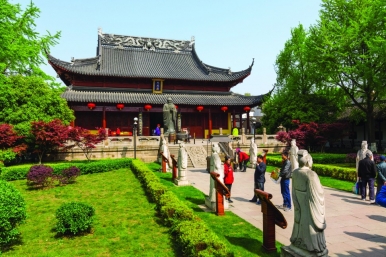China’s fast-growing city of Nanjing offers nature, history and urbanisation

Riding past the languid Qinhuai River by bicycle, two key halves of Nanjing reveal themselves: natural and cultural.
As an estuary city deep up the Yangtze River from Shanghai, Nanjing’s haunted modern history of World War II atrocities can overwhelm and overshadow its larger legacy – a past made possible by the region’s nature. The long, flowing Chanjiang, or Yangtze River, has made this a rice farming heaven for centuries. Chinese farmers have raised rich estates with pigs, chickens, fishponds, and duck pens – all of which have added to a unique culinary tradition. Indeed, the famed Peking Duck dish was originally from Nanjing.
During its long and storied history, Nanjing has served as a political and cultural capital – going back to 220 CE. It was one of the Four Great Ancient Capitals of China. It served as the capital during parts of the Ming dynasty from 1368 to 1421 when it was the world’s largest city with half a million people. The famous admiral Zheng He who went on seven international voyages for the Ming court across the rim of the Indian Ocean, Middle East, and Southeast Asia from 1405 to 1433 was from Nanjing. In modern times, it was the capital from 1921 to 1937 and from 1945 to 1949.
Today, it is a city with nearly nine million people with China’s largest inland port. I discovered this fact while cycling for an hour out of downtown through the Kou district, passing endless fields of rice peppered with small factories. Here, one can sample locally farmed shrimp with duck broth and slices of ginger served at small shops. I stepped into one of these shops after a long morning of cycling to catch the natural side of Nanjing outside the urban jungle encased in its Ming Dynasty walls.

I had initially set my sights on cycling up to the Purple Mountain but got distracted by many of the alluring and secret sites that biking around the river can offer. Running through central Nanjing, the historic Qinhuai River has nurtured the ancient city for thousands of years.
The city, as a general rule, is user-friendly for cyclists with marked lanes, though local electric bikes and motorbikes can jam into them too. Even if you’re not up for biking around the city, you can find natural oases in the city itself.

The old city ebbs out from Xuanwu Lake Park. I was lucky to be there in September when the maples bloom resilient red. Another trip in March was also nice because Spring witnesses incredible pink cherry blossoms. These are the easiest seasons, weather-wise, to enjoy the many hours one can spend strolling through the park and its five islands because summer is steamy and winter biting cold. It is also ideal to bike around as the islands are connected with bridges. There are paddleboats too.
A few other nature parks in the city reveal its steeped culture. With a wall and gate section stretching back to 1367, the Wuchaomen is also optimal for taking in nature during any season. For summer, the forest-shrouded Qingliangshan Park is delightful with its winding paths and several teahouses. Another summer spot is Mochou Lake. Famed for its ‘Don’t Worry Moniker’, the classic courtyards and summer Duanwu or Dragon Boat festivals in June add to its charm. Next to the Grand City Wall castle, there is another charming park with floral and manicured aplomb.
_386_257.jpg)
Ming history buffs will want to take in the Ming Dynasty Imperial Palace to fully appreciate the wall and the park there.
The same can be said of all visitors to Nanjing, which is to access it with a view towards nature – it’s a refreshing way to appreciate this city as Chinese have for centuries.









